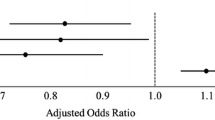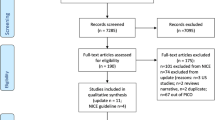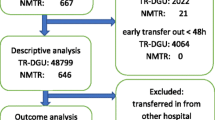Abstract
Introduction
Trauma is a leading cause of mortality and disability in children worldwide. The World Health Organization reports that 95% of all childhood injury deaths occur in Low–Middle-Income Countries (LMIC). Injury scores have been developed to facilitate risk stratification, clinical decision making, and research. Trauma registries in LMIC depend on adapted trauma scores that do not rely on investigations that require unavailable material or human resources. We sought to review and assess the existing trauma scores used in pediatric patients. Our objective is to determine their wideness of use, validity, setting of use, outcome measures, and criticisms. We believe that there is a need for an adapted trauma score developed specifically for pediatric patients in low-resource settings.
Materials and methods
A systematic review of the literature was conducted to identify and compare existing injury scores used in pediatric patients. We constructed a search strategy in collaboration with a senior hospital librarian. Multiple databases were searched, including Embase, Medline, and the Cochrane Central Register of Controlled Trials. Articles were selected based on predefined inclusion criteria by two reviewers and underwent qualitative analysis.
Results
The scores identified are suboptimal for use in pediatric patients in low-resource settings due to various factors, including reliance on precise anatomic diagnosis, physiologic parameters maladapted to pediatric patients, or laboratory data with inconsistent accessibility in LMIC.
Conclusion
An important gap exists in our ability to simply and reliably estimate injury severity in pediatric patients and predict their associated probability of outcomes in settings, where resources are limited. An ideal score should be easy to calculate using point-of-care data that are readily available in LMIC, and can be easily adapted to the specific physiologic variations of different age groups.

Similar content being viewed by others
References
Mock C, Abantanga F, Goosen J, Joshipura M, Juillard C (2009) Strengthening care of injured children globally. Bull World Health Organ 87(5):382–389
Krug E (2006) The International Society for Violence and Injury Prevention. Inj Prevent 12(4):210
United Nations Millenium Development Project Goals. http://www.unmillenniumproject.org/goals/. Accessed 7 June 2016
Howard JM (2000) Historical background to accidental death and disability: the neglected disease of modern society. Prehosp Emerg Care 4(4):285–289
Canadian Health Services Research Foundation and Canadian Institutes of Health Research IoHSaPR. Listening for direction: final report to Health Canada 2007. http://www.chsrf.ca/Libraries/Listening_for_Direction/LfDIII-NRFinal_ENG_05_09_08.sflb.ashx. Accessed 29 Sept 2014
Canada SK (2006 ) Child and youth unintentional injury: 1994–2003; 10 years in review. http://www.mhp.gov.on.ca/en/prevention/injury-prevention/skc_injuries.pdf. Accessed 29 Sept 2014
Kobusingye OC, Lett RR (2000) Hospital-based trauma registries in Uganda. J Trauma 48(3):498–502
O’Reilly GM, Joshipura M, Cameron PA, Gruen R (2013) Trauma registries in developing countries: a review of the published experience. Injury 44(6):713–721
Mayer T, Matlak ME et al (1980) The modified injury severity scale in pediatric multiple trauma patients. J Pediatr Surg 15(6):719–726
Alberico AM, Ward JD et al (1987) Outcomes after severe head injury. J Neurosurg 67:648–656
Tepas JJ, Mollitt DL et al (1987) The Pediatric Trauma Score as a predictor of injury severity in the injured child. J Pediatr Surg 22(1):14–18
Walker PJ, Cass DT (1987) Paediatric trauma: urban epidemiology and an analysis of methods for assessing the severity of trauma in 598 injured children. Aust NZ J Surg 57:715–722
Cottington EM, Young JC et al (1988) The utility of physiologic status, injury site, and injury mechanism in identifying patients with major trauma. J Trauma 28(3):305–311
Reilly PL, Simpson DA et al (1988) Assessing the conscious level in infants and young children: a paediatric version of the Glasgow Coma Scale. Child’s Nerv Syst 4:30–33
Tepas JJ, Ramenofsky ML et al (1988) The Pediatric Trauma Score as a predictor of injury severity: an objective assessment. J Trauma 28(4):425–429
Chan H, Walker PJ et al (1989) Urban trauma: an analysis of 1116 paediatric cases. J Trauma 29(11):1540–1547
Pillgram-Larsen J, Marcus M, Svennevig JL (1989) Assessment of probability of survival in penetrating injuries using the TRISS methodology. Injury 20(1):10–12
Aprahamian C, Cattey RP et al (1990) Pediatric Trauma Score, predictor of hospital use ? Arch Surg 125(1128):1131
Breaux CW, Smith G, Georgeson KE (1990) The first two years’ experience with major trauma at a pediatric trauma center. J Trauma 30(1):37–43
Champion HR, Copes WS et al (1990) A new characterization of injury severity. J Trauma 30(5):539–546
Kauffman CR, Maier RV et al (1990) Evaluation of the Pediatric Trauma Score. JAMA 263(1):69–72
Rhee KJ, Baxt WG et al (1990) APACHE II scoring of the injured patient. Crit Care Med 18(8):827–830
Benzer A, Mitterschiffthaler G et al (1991) Prediction of non-survival after trauma: Innsbruck coma scale. Lancet 338:977–978
Bond SJ, Gotschall CS, Eichelberger MR (1991) Predictors of abdominal injury in children with pelvic fracture. J Trauma 31(8):1169–1173
Bull JP, Dickson GR (1991) Injury scoring by TRISS and ISS/age. Injury 21(2):127–131
Kauffman CR, Maier RV et al (1991) Validity of applying TRISS analysis to injured children. J Trauma 31(5):691–698
Krob MJ, D’Amico FJ, Ross DL (1991) Do trauma scores accurately predict outcomes for patients with burns ? J Burn Care Rehabil 12(6):560–563
Nayduch DA, Moylan J et al (1991) Comparison of the ability of adult and Pediatric Trauma Scores to predict pediatric outcomes following major trauma. J Trauma 31(4):452–458
Bahk E, Özok G et al (1993) Pediatric Trauma Score: is it reliable in predicting mortality? Pediatr Surg Int 8:54–55
Eichelberger MR, Champion HR et al (1993) Pediatric coefficients for TRISS analysis. J Trauma 34(3):319–322
Teijink JA, Dwars BJ et al (1993) Scoring multitrauma patients: which scoring system? Injury 24(1):13–16
Gotschall CS, Papero PH et al (1995) Comparison of three measures of injury severity in children with traumatic brain injury. J Neurotrauma 12(4):611–619
Sampalis JS, Boukas S et al (1995) Preventable death classification: interrater reliability and comparison with ISS-based survival probability estimates. Accid Anal Prev 27(2):199–206
Champion HR, Copes WS et al (1996) Improved predictions from A Severity Characterization of Trauma (ASCOT) over Trauma and Injury Severity Score (TRISS): results of an independent evaluation. J Trauma 40(1):42–49
Massagli TL, Michaud LJ, Rivara FP (1996) Association between injury indices and outcome after severe traumatic brain injury in children. Arch Phys Med Rehabil 77:125–132
Philips S, Rond P et al (1996) The need for pediatric-specific triage criteria: results from the Florida trauma triage study. Pediatr Emerg Care 12(6):394–399
Wan GJ, Neff-Smith M (1996) The impact of demographics, injury severity, and trauma type on the likelihood of survival in child and adolescent trauma patients. J Trauma 40(3):412–416
Rutledge R, Hoyt DB, Eastman AB et al (1997) Comparison of the Injury Severity Score and ICD-9 diagnosis codes as predictors of outcome in injury: analysis of 44,032 patients. J Trauma Inj Infect Crit Care 42(3):477–487
Tepas JJ, Veldenz H et al (1997) Pedatric risk indicator: an objective measurement of childhood severity injury. J Trauma 43(2):258–262
Beattie TF, Currie CE et al (1998) Measures of injury severity in childhood: a critical overview. Inj Prev 4:228–231
Orliaguet GA, Meyer PG et al (1998) Predictive factors of outcome in severely traumatized children. Pediatr Anesth 87:537–542
Zuckerman GB, Gregory PM, Santos-Damiani S (1998) Predictors of death and neurologic impairment in pediatric submersion injuries. Arch Pediatr Adolesc Med 152:134–140
Castello FV, Cassan A et al (1999) The Pediatric Risk of Mortality (PRISM) score and Injury Severity Score (ISS) for predicting resource utilization and outcome of intensive care in pediatric trauma. Crit Care Med 27(5):985–988
Adesunkanmi ARK, Oginni LM et al (2000) Road traffic accidents to African children: assessment of severity using the Injury Severity Score (ISS). Inj Int J Care Inj 31:225–228
DiRusso SM, Sullivan T et al (2000) An artificial neural network as a model for prediction of survival in trauma patients: validation for a regional trauma area. J Trauma 49:212–223
Durham SR, Clancy RR et al (2000) CHOP Infant Coma Scale (“Infant Face Scale”): a novel coma scale for children less than two years of age. J Neurotrauma 17(9):729–737
Engum SA, Mitchell MK et al (2000) Prehospital triage in the injured pediatric patient. J Pediatr Surg 35(1):82–87
Hannan EL, Szypulski L et al (2000) Predicting inpatient mortality for pediatric trauma patients with blunt injuries: a better alternative. J Pediatr Surg 35(2):155–159
Ott R, Krämer R et al (2000) Prognostic value of trauma scores in pediatric patients with multiple injuries. J Trauma 49:729–736
Condello AS, Hancock BJ et al (2001) Pediatric trauma registries: the foundation of quality care. J Pediatr Surg 36:685–689
Grisoni E, Stallion A et al (2001) The NISS and the evaluation of pediatric trauma. J Trauma 50:1006–1110
Potoka DA, Schall LC, Ford HR (2001) Development of a novel age-specific Pediatric Trauma Score. J Pediatr Surg 36(1):106–112
Letts M, Davidson D, Lapner P (2002) Multiple trauma in children: predicting outcome and long-term results. Can J Surg 45(2):126–131
Newgard CD, Lewis RJ, Jolly BT (2002) Use of out-of-hospital variables to predict severity of injury in pediatric patients involved in motor-vehicle crashes. Ann Emerg Med 39(5):481–491
Ortzuk H, Docuku AI et al (2002) The prognostic importance of trauma scoring systems for morbidity in children with penetrating abdominal wounds: 17 years of experience. J Pediatr Surg 37(1):93–98
Schall LC, Potoka DA, Ford HR (2002) A new method of estimating probability of survival in pediatric patients using revised TRISS methodology based on age-adjusted weights. J Trauma 52:235–241
Gunay Y, Yazuv MF, Esiyok B (2003) Comparison of Turkish Injury Scale (TIS) with the Abbreviated Injury Scale (AIS). Forensic Sci Int 132:1–4
Sullivan T, Haider A et al (2003) Prediction of mortality in pediatric trauma patients: new injury severity score outperforms injury severity score in the severly injured. J Trauma 55:1083–1088
Murlidhar V, Roy N (2004) Measuring trauma outcomes in India: an analysis based on TRISS methodology in a Mumbai university hospital. Inj Int J Care Inj 35:386–390
Tay ST, Sloan EP et al (2004) Comparison of the new injury severity score and the injury severity score. J Trauma 56:162–164
Coates BM, Vavilala MS et al (2005) Influence of definition and location of hypotension on outcome following severe pediatric traumatic brain injury. Crit Care Med 33(11):2645–2650
Abib S, Schettini SG et al (2006) Prehospital pediatric trauma classification (PHPTC) as a tool for optimizing trauma care resources in the city of Sao Paolo, Brazil. Acta Cir Bras 21(1):7–11
Bouamra O, Wrotchford A et al (2006) A new approach to outcome prediction in trauma: a comparison with the TRISS model. J Trauma 61:701–710
Burd RS, Jang TS, Nair SS (2006) Predicting hospital mortality among injured children using a national trauma database. J Trauma 60(792):801
Ducrocq SC, Meyer PG, et al (2006) Epidemiology and early predictive factors of mortality and outcome in children with traumatic severe brain injury: experience of a French pediatric trauma center. Pediatr Crit Care Med 7(5):461, 467
Rautji R, Bhardwaj DN, Dogra TD (2006) The Abbreviated Injury Scale and its correlation with preventable traumatic accidental deaths: a study from South Delhi. Med Sci Law 46(2):157–165
Cuff S, DiRusso S et al (2007) Validation of a relative head injury severity scale for pediatric trauma. J Trauma 63:172–178
Grinkeviciute DE, Kevalas R et al (2007) Predictive value of scoring system in severe pediatric head injury. Medicina 43(11):861–869
Rabbani A, Moini M (2007) Application of “Trauma and Injury Severity Score” and “A Severity Characterization of Trauma” Score to trauma patients in a setting different from “Major Trauma Outcome Study”. Arch Iran Med 10(3):383–386
Tamim H, Al Hazzouri AZ et al (2008) The injury severity score or the new injury severity score for predicting mortality, intensive care unit admission, and length of hospital stay: experience from a university hospital in a developing country. Inj Int J Care Inj 39:115–120
Tepas JJ, Leaphart CL et al (2008) Risk stratification simplified: the worst injury predicts mortality for the injured children. J Trauma 65:1258–1263
Brunengraber LN, Robinson AV, Chwals WJ (2009) Relationship of serum C-reactive protein and blood glucose levels with injury severity and patient morbidity in a pediatric trauma population. J Pediatr Surg 44:992–996
Hariharan S, Chen D et al (2007) Evaluation of trauma care applying TRISS methodology in a Carribean developing country. Int Emerg Med 9:85–90
Hindy-François C, Meyer P et al (2009) Admission base deficit as a long-term prognostic factor in severe pediatric trauma patients. J Trauma 67(6):1272–1277
Karam O, Sanchez O et al (2009) Blunt abdominal trauma in children: a score to predict the absence of organ injury. J Pediatr 154(6):912–917
Narci A, Solak O et al (2009) The prognostic importance of trauma scoring systems in pediatric patients. Pediatr Surg Int 25:25–30
Tude-Melo JR, Di Rocco F et al (2010) Mortality in children with severe head trauma: predictive factors and proposal for a new predictive scale. Neurosurgery 67:1542–1547
Afuwape OO, Okolo CA, Akinyemi OA (2011) Preventable trauma deaths in Ibadan: a comparison of revised trauma score and panel review. West Afr J Med 30(1):19–23
Borgman MA, Maegele M, Wade CE, Blackbourne LH, Spinella PC (2011) Pediatric trauma BIG score: predicting mortality in children after military and civilian trauma. Pediatrics 127:e892
Haider AH, Crompton JG et al (2011) Mechanism of injury predicts case fatality and functional outcomes in pediatric trauma patients: the case for its use in trauma outcomes studies. J Pediatr Surg 46:1557–1563
Buyukcam F, Kaya U et al (2012) Predicting the outcome in children with head trauma: comparison of FOUR score and Glasgow Coma Scale. Turk J Trauma Emerg Surg 18(6):469–473
Belzenugi T, Gradin C et al (2013) Major trauma registry of Navarre (Spain): the accuracy of different survival prediction models. Am J Emerg Med 31:1382–1388
Levi Y, Jeroukhimov I et al (2013) Base excess as a predictor for injury severity in pediatric trauma patients. J Emerg Med 45(4):496–501
Cassidy LD, Cook A et al (2014) Is the trauma mortality prediction model (TMPM-ICD-9) a valid predictor of mortality in pediatric trauma patients ? J Pediatr Surg 49:189–192
Vallipakorn SA, Plitapolkarnpim A et al (2014) Risk prediction score for death of traumatised and injured children. BMC Pediatr 14:60–72
Weeks SR, Juillard CJ et al (2014) Is the Kampala Trauma Score an effective predictor of mortality in low-resource settings? A comparison of multiple trauma severity scores. World J Surg 38:1905–1911
Eid HO, Abu-Zidan FM (2015) New Injury Severity Score is a better predictor of mortality for blunt trauma patients than the injury severity score. World J Surg 39:165–171
The World Bank New Country Classifications. http://data.worldbank.org/news/new-country-classifications. Accessed 21 May 2016
Baker SP, O’Neill B, Haddon W Jr, Long WB (1974) The injury severity score: a method for describing patients with multiple injuries and evaluating emergency care. J Trauma 14(3):187–196
Copes WS, Sacco WJ et al. Progress in characterising anatomic injury. In: Proceedings of the 33rd annual meeting of the association for the advancement of automotive medicine, Baltimore MA, USA, pp 205–218
Rutledge R, Fakhry S, Baker C et al (1993) Injury severity grading in trauma patients: a simplified technique based upon ICD-9 coding. J Trauma 35:497
Osler T, Rutledge R, Dies J et al (1996) ICISS: an international classification of disease 9 based Injury Severity Score. J Trauma 41:380
Osler T, Baker SP, Long W (1997) A modification of the injury severity score that both improves accuracy and simplifies scoring. J Trauma 43:922–925
Sacco WJ, MacKenzie EJ, Champion HR, Davis EG, Buckman RF (1999) Comparison of alternative methods for assessing injury severity based on anatomic descriptors. J Trauma 47:441–446
Burri, Allgöwer et al (1972) Central venous pressure and shock index in the severely injured. Helv Chir Acta 39:107–111
Pollack CV, Ruttiman et al (1988) Pediatric Risk of Mortality (PRISM) Score. Crit Care Med 16:1110–1116
Champion HR, Sacco WJ et al (1981) The Trauma Score. Crit Care Med 9:672
Shann F, Pearson G, Slater A, Wilkinson K (1997) Paediatric index of mortality (PIM): a mortality prediction model for children in intensive care. Intensive Care Med 23:201–207
Davis AL, Wales PW, Malik T et al (2015) The BIG score and prediction of mortality in pediatric blunt trauma. J Pediatr 167(3):593–598
Kauffman CR, Maier RV et al (1995) Evaluation of the Pediatric Trauma Score. JAMA 263(1):69–72
Boyd CR, Tolson MA et al (1987) Evaluating Trauma Care: the TRISS Method. J Trauma 27:370
Hoffman F, Schmalhofer M et al (2016) Comparison of the AVPU Scale and the pediatric GCS in prehospital setting. Prehosp Emerg Care 20(4):493–498
Committee on Trauma, American College of Surgeons (2008) Chapter 10: pediatric surgery. In: ATLS: advanced trauma life support program for doctors (8th ed). American College of Surgeons, Chicago
Chan M (2012) From new estimates to better data. Lancet 380(9859):2054
Murray CJ, Vos T et al (2012) Disability-adjusted life years (DALYs) for 291 diseases and injuries in 21 regions, 1990–2010: a systematic analysis for the Global Burden of Disease Study 2010. Lancet 380(9859):2197–2223
World Health Organization (2009) Chapter 4: techniques of quality improvement. In: Guidelines for trauma quality improvement programmes. World Health Organization, p 44
Acknowledgements
E. St-Louis is funded by the Surgeon Scientist Program at McGill University, the Canadian Institute of Health Research (CIHR), and the Fonds de recherche du Québec en Santé (FRQS). The Centre for Global Surgery was supported by the Montreal General Hospital Foundation.
Author information
Authors and Affiliations
Corresponding author
Electronic supplementary material
Below is the link to the electronic supplementary material.
Rights and permissions
About this article
Cite this article
St-Louis, E., Séguin, J., Roizblatt, D. et al. Systematic review and need assessment of pediatric trauma outcome benchmarking tools for low-resource settings. Pediatr Surg Int 33, 299–309 (2017). https://doi.org/10.1007/s00383-016-4024-9
Accepted:
Published:
Issue Date:
DOI: https://doi.org/10.1007/s00383-016-4024-9




